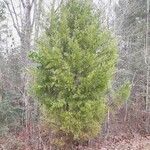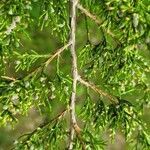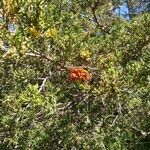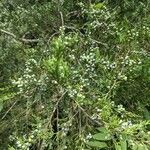Shrub or tree with a dense crown, to 20 m; juvenile lvs subulate, pungent, 5–7 mm, spreading or ascending; lvs of adult branches scale-like, appressed, ovate or lance-ovate, 2–4 mm, obtuse or subacute, convex on the back; cones terminal on short, straight peduncles, subglobose, blue-glaucous, 5–7 mm thick; seeds 1 or 2, pitted toward the base. In a variety of soils, esp. in dry, calcareous sites; s. Me. and s. Que. to N.D., s. to Ga., nw. Fla., and Tex. Two weakly distinguished vars.: Var. virginiana, occurring from Va. to s. Mo. and southward, has a relatively broad, ovoid crown with widely spreading branches, and the seeds are strongly pitted. Var. crebra Fernald, the more northern phase, has a narrowly spire-shaped crown with distinctly ascending branches, and the seeds are only obscurely pitted.
Trees to 30 m, dioecious; bark reddish brown; crown columnar-conical or conical; branches erect or spreading; branchlets thin, 4-angled, ca. 0.8 mm in diam. Leaves both scalelike and needlelike; needlelike leaves usually present on young plants, rarely present on adult plants, decussate or in whorls of 3, ascending, glaucous, 5-6 mm, concave adaxially; scalelike leaves decussate, rhombic-ovate, 1.5-3 mm, concave, abaxial gland basal, elliptic or ovate. Pollen cones 2-3 × ca. 1.5 mm; microsporophylls 8-12, each with 3 or 4 pollen sacs. Seed cones bluish green when ripe, glaucous, globose to ovoid, 4-6(-7) × 3-5.5 mm, 1-or 2-seeded. Seeds ovoid, 3-5 × 3-4 mm.
A tree. It grows 15-30 m tall and spreads 4.5-7.5 m wide. It is often conical in shape. The trunk can be 20 cm across. The bark is brown and comes away in shreds. The twigs are slender and 4 sided. The leaves are grey-green with patches of waxy young leaves. The adult leaves are scale like. They are 2 mm long and pointed. Successive pairs of leaves overlap. The needles are 12 mm long and often on the same branch as the scale leaves. The fruit are brown-blue berries. They are 3-6 mm across. They have a white bloom. They contain 1 or 2 seeds.
Evergreen tree, up to 18 m high, initially conical, later with horizontal spreading branches; dioecious. Leaves of two types with adult ones scale-like, overlapping, acute, ± 1.5 mm long and juvenile leaves needle-like, up to 10 mm long. Cones indehiscent, globose, ± 6 mm in diameter, berry-like, dark blue with a bluish grey bloom.
Evergreen, dioecious tree, up to 18 m high; bark grey to reddish brown, peeling in strips. Leaves: juvenile leaves needle-like, usually in opposite pairs; adult leaves overlapping, scale-like, acute ± 1.5 mm long. Female cones ± globose, fleshy, 6 mm in diam., remaining closed, usually dark blue.













